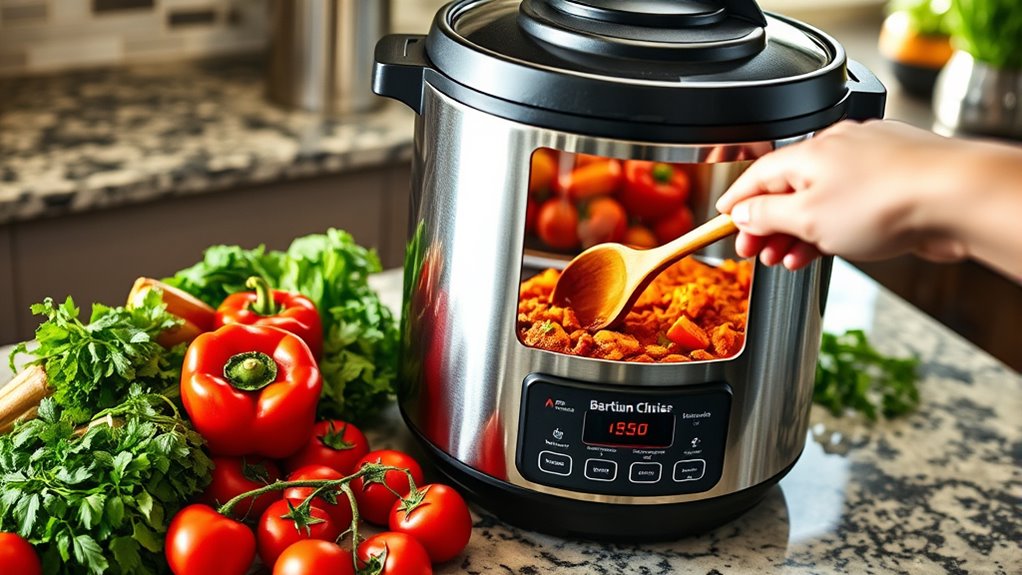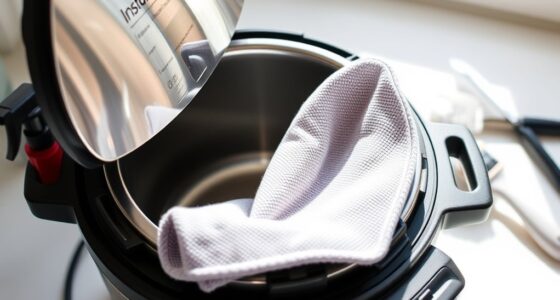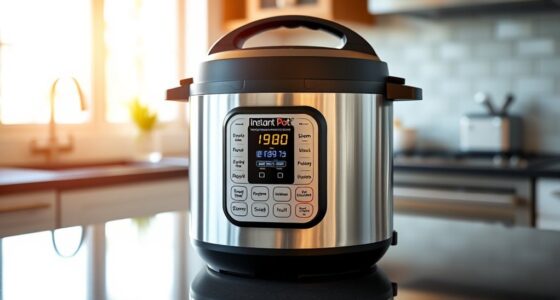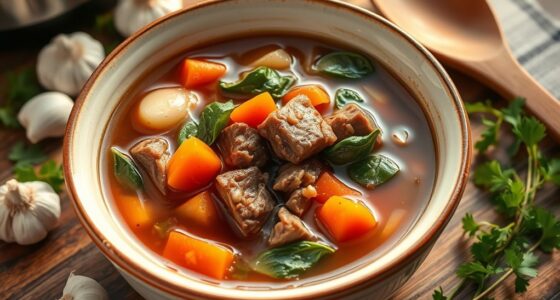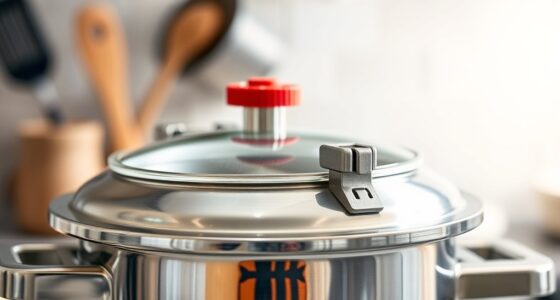To convert traditional recipes for your multicooker, start by adjusting cooking times to be shorter and set the appropriate pressure levels for each ingredient. Keep in mind that some ingredients cook faster, so reduce times accordingly and watch for overcooking. Swap out ingredients like dairy or grains to suit dietary needs, and remember, experimenting with small adjustments can help perfect your dishes. Continue exploring these tips to master effortless cooking with your multicooker.
Key Takeaways
- Adjust cooking times based on your multicooker’s instructions to prevent over or undercooking.
- Use appropriate pressure levels for different ingredients to optimize texture and flavor.
- Substitute ingredients thoughtfully, considering their cooking rates and how they affect dish consistency.
- Reduce traditional long cooking times, especially for tougher cuts, to suit quick-pressure cooking.
- Incorporate maintenance and proper sealing techniques to ensure consistent results and prolong your multicooker’s lifespan.
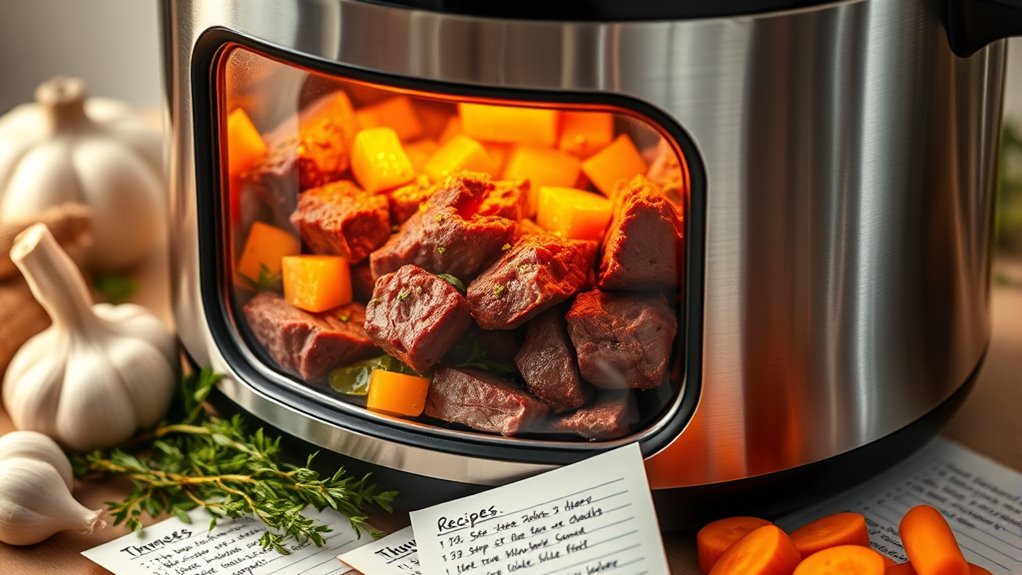
Have you ever wondered how to adapt your favorite traditional recipes for modern kitchens or specific dietary needs? Converting classic dishes to work seamlessly in a multicooker can seem tricky at first, but understanding pressure cooking techniques and ingredient substitutions makes it straightforward. Pressure cooking techniques allow you to cut down cooking time substantially while preserving flavors and textures that often require hours of simmering on the stovetop. When adapting recipes, you’ll want to adjust the cooking times and pressure levels according to your device’s instructions, ensuring the ingredients reach the right tenderness without overcooking. For example, tougher cuts of meat that traditionally need long braising can be cooked under high pressure for a fraction of the time, resulting in tender, flavorful results. This method not only saves time but also locks in nutrients and intensifies flavors, making your dishes richer and more satisfying. Incorporating appropriate filtration and maintenance practices can help keep your multicooker in top condition, ensuring consistent results and longevity of the appliance. Ingredient substitutions are equally essential when converting recipes, especially if you’re catering to dietary restrictions or aiming for healthier options. For instance, if a traditional recipe calls for heavy cream, you might swap it for coconut milk or cashew cream to reduce dairy content. Similarly, replace refined grains with whole grains or legumes to boost fiber and nutrients. When working with pressure cooking techniques, some substitutions will cook faster or slower than the original ingredients, so it’s important to adjust your timing accordingly. For example, if you’re substituting lentils for beans, keep in mind that lentils generally cook faster, so you might need to reduce the pressure cooking time to prevent over-softening. Using ingredient substitutions also helps you adapt recipes to your taste preferences or to what’s available in your pantry. For example, if a traditional stew calls for potatoes but you want to reduce carbs, cauliflower florets make an excellent low-carb alternative that cooks quickly and absorbs flavors beautifully under pressure. When making these swaps, consider the texture and cooking times to avoid ending up with mushy or undercooked components. Trial and error can be part of the process, but with some practice, you’ll develop an intuitive sense of how different ingredients respond to pressure cooking. Ultimately, converting traditional recipes for the multicooker involves understanding pressure cooking techniques and making thoughtful ingredient substitutions. These adjustments help you retain the essence of the original dish while optimizing it for modern convenience and dietary needs. With a little experimentation and patience, you’ll be able to enjoy classic flavors in a fraction of the time, all while customizing each dish to suit your preferences and lifestyle.
Frequently Asked Questions
Can I Adapt Recipes With Dairy or Eggs for the Multicooker?
Yes, you can adapt recipes with dairy or eggs for the multicooker. Use dairy substitutions like almond milk, coconut yogurt, or dairy-free cream to replace milk or cream. For eggs, try egg replacements such as applesauce, mashed bananas, or commercial egg replacers. Keep in mind that these swaps might slightly alter texture or flavor, so experiment to find the best balance for your dish.
Are There Specific Ingredients to Avoid When Converting Recipes?
Ever wonder which ingredients might not work well in your multicooker? You should steer clear of ingredients that don’t adapt easily, like delicate seafood or ingredients requiring precise timing, as well as those needing quick reduction or thickening. When making ingredient substitutions, consider flavor adjustments to maintain taste. Are there any ingredients you’re unsure about? Sticking to versatile, hearty ingredients ensures your dish turns out delicious every time.
How Does Altitude Affect Cooking Times in a Multicooker?
Altitude affects cooking times in your multicooker due to pressure variations, which lower at higher elevations. You should make altitude adjustments by increasing cooking time or adjusting pressure settings accordingly. At higher altitudes, you’ll need to compensate for the lower boiling point and pressure changes to ensure your food cooks thoroughly. Keep in mind that these adjustments help attain the desired results despite the altitude-related differences in pressure and cooking efficiency.
Can I Use Traditional Recipes With Frozen Ingredients in a Multicooker?
Imagine tossing frozen ingredients into your multicooker like a snowstorm in a teapot—chaotic and probably a bit risky. You can use frozen ingredients, but expect longer cook times and potential uneven heating. For best results, adapt your recipe to account for the frozen state—add extra liquid, extend cooking time, and stir occasionally. Proper recipe adaptation guarantees your dish turns out delicious, not icy or undercooked.
What Is the Best Way to Adjust Seasoning When Converting Recipes?
When adjusting seasoning, start with less than the original recipe calls for, as flavors can become more concentrated during cooking. Taste the dish after pressure release and add seasoning gradually to achieve flavor balancing. Remember, multicooker cooking can intensify flavors, so it’s best to modify seasoning in small increments. This way, you prevent over-seasoning and ensure your dish tastes just right.
Conclusion
Now that you’ve mastered converting traditional recipes for your multicooker, you’re all set to savor speedy, simple, and satisfying meals. With a little patience and practice, you’ll perfect your process and enjoy delicious dishes without the drama of stovetop stress. So, plunge into daring culinary experiments, delight in your dishes, and discover how convenient cooking can be. Remember, with a bit of boldness and a dash of daring, your multicooker magic awaits!
